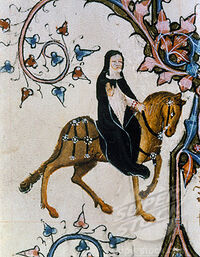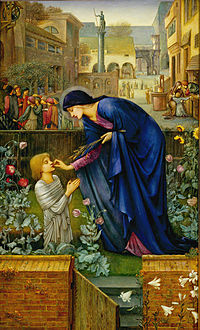
Image of the Prioress from an early manuscript of The Canterbury Tales. The manuscript is now in the Huntington Library, San Marino, California.
"The Prioress's Tale" (Middle English: "The Prioresses Tale") is a short story in verse from The Canterbury Tales by Geoffrey Chaucer. The tale concerns a young Christian boy who is murdered by Jews. His murder is discovered when he miraculously continues to sing after his throat has been cut. The tale deals with themes that were popular in medieval Christian stories; including an innocent martyr who dies for his faith, a miracle performed by the Virgin Mary and the blood libel against the Jews.
It is unclear exactly what Chaucer's attitude is towards the story and its teller. The Prioress, named as Madame Eglentyne in the "General Prologue", is not presented as an altogether sympathetic character. Her impeccable table manners and preference for speaking French (using an old-fashioned English pronunciation and being unable to understand the language as it is spoken in France) suggest that she is from a wealthy background and that she may have entered religious life as a means of greater social advancement. The Prioress appears to continue to lead a largely secular lifestyle; she keeps dogs which she prefers to people and wears a brooch with the Latin motto Amor vincit omnis ("Love conquers all") written on it. The fact that "The Prioress's Tale" is written in a rhyme structure called "rhyme royal" which is more normally used for courtly romances has been put forward as evidence that Chaucer is making fun of the Prioress.
Nevertheless, many modern readers are likely to find the blatant anti-Semitism and general religious intolerance in the tale to be highly uncomfortable reading.
Plot[]
The story takes place in a city in Asia with a majority Christian population and a Jewish minority. The area where the Jews live is not walled off from the rest of the city and Christian children regularly pass through it on their way to a nearby school.
The story's protagonist is a young schoolboy who is devoted to the Virgin Mary and always stops to say a prayer whenever he sees her image. One day at school, he hears some older pupils sing the hymn "Alma Redemptoris Mater". Although he does not understand the hymn's Latin words, he is moved by it and soon learns the hymn's first verse by heart. The boy asks an older friend to tell him what the hymn means. The boy's friend tells him that he does not fully understand it either because his Latin is poor but explains that the hymn is about the Virgin Mary. On hearing this, the boy becomes determined to learn the entire hymn off by heart, which, with his friend's help, he soon does.

The Virgin Mary places the seed on the boy's tongue. 19th century painting by Edward Burne-Jones.
The boy sings the hymn every morning as he goes to school and every evening as he returns home again, passing through the Jewish quarter as he does so. The Devil causes the Jews to get angry and take offence at this. One day, the boy is snatched, his throat is slit and his body is thrown into a latrine.
When the boy does not return home, his widowed mother becomes worried. Having heard that he was last seen in the Jewish quarter, she goes looking for him there. When she calls out his name, the boy miraculously begins to sing "Alma Redemptoris Mater" from the place where his body is lying. The truth about the boys murder is discovered and all those responsible for it are hanged. The boy continues to sing when his body is removed from the pit and taken to the church.
The abbot demands to know how the boy can continue to sing even though his throat has been cut. The boy explains that the Virgin Mary came to him and placed a seed on his tongue. The boy explains that it was thanks to the miraculous seed that he was able to continue singing and reveal where his body had been hidden. He adds that the Virgin Mary will come to collect his soul when the seed is removed. The abbot removes the seed and the boy's body is placed in a white marble tomb.
The Prioress concludes her tale by referring to Little Saint Hugh of Lincoln, an English boy who was said to have been murdered by Jews in 1255 and who became an object of popular devotion amongst Christians in the country.
